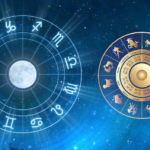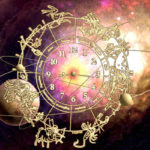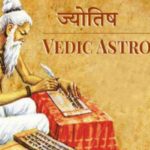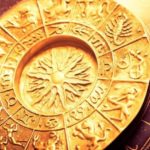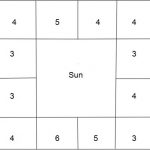Vedic Astrology
Vedic astrology is one of the Vedangas, and offers us a rich symbolic language complete with deities and myths assigned to each portion of the sky. While western astrology uses the original placement of the constellations from thousands of years ago, Vedic astrology adheres to the astronomically accurate position of the constellations as they stand today.
Vedic astrology allows for an accuracy that is best for predictions and tapping into the eternal significance of your sign. The night sky is divided up into 27 moon mansions called “Nakshatras”.
These nakshatras each have their own deity, symbol, ruling planet and mythological story which can serve as a portal for personal transformation. Engaging with this profound system leads to a greater understanding of the way in which we interact with friends, family and life partners, helping us connect to the deeper meaning of life’s events.
Vedic astrology’s connection to the ancient science of Ayurveda means in addition to being a rich source of knowledge, it is a healing tool that can improve wellbeing of mind and body. Vedic astrology prescribes remedies for troublesome planets through the use of gemstones, rituals, and mantras to help us thrive.
Jyotish-Chititsa translates to God’s light and vedic astrology can help us remember our own divine spark within. Jyotish is not so much about fortune telling, as much as understanding our constitution and times when we are more likely to experience imbalances and when we are more able to shine.
Indian Vedic Astrology is also known as Vedic Jothish. The word “Vedic” means “wisdom and truth” while the word “Jyotish” is formed of two words, i.e. Jyot means Light and Isht meaning God. Hence Vedic Jyotish means “True Light of God”. Jyotish is also known as an “eye” because it allows us to understand our past, present and future and also reveal our personality traits
What is vedic astrology? signs
Origin Of Indian Vedic Astrology
The study of astrology or Jyotishshastra can be traced to the Vedic times. Glimpses of astrological traditions are visible in the Atharva-Veda, one of the most sacred texts of India. Indian Vedic Astrology is very ancient and the oldest system of astrology.
As per the estimates from Puranic Time and the Archaeological Record, the Indian Vedic astrology has the age of about 5000 BC. Rooted in the Vedas, India’s ancient system of knowledge, Vedic astrology is based on the belief that the Nakshatras and Planets have a powerful influence on our lives.
The Vedas say that a person’s karma is directly related to the position of the planets and stars, and thus astrology is the method of understanding one’s karma by analyzing these positions.
The history of astrology is explained in the sacred Vedas of Hinduism. It is believed that Indian Vedic Astrology is based on one of the six supplements of Vedas known as Vedangas. Ancient sages like Vashistha, Bhrigu, and Garga were the experts of Vedic astrology and made many accurate and precise predictions.
Then sage Parasara wrote Brhad Parasara Hora Sastra, before the beginning of Kali Yug . He even taught it to one of his disciples, sage Maitreya and so on. This way, the Indian Vedic Astrology made a long journey. Then it even passed to Persian, then to Babylonians, then to Greeks, Romans and Egyptians.
Vedic astrology or jyotiṣa, originated in ancient India around 2500 years ago. Jyotiṣa is a Sanskrit term that can be rendered ‘science of light’ and combines mathematical astronomy with Vedic lore to describe how time and our freewill shape the quality of our destiny. Traditionally. Jyotiṣa consists of three divisions:
Gaṇita: Mathematics and astronomy.
Horā: Horoscopy, and has two divisions: Jātaka or birth chart interpretation and muhurta or electional astrology.
Saṁhitā: Deals with a wide variety of astrological and related topics and is somewhat similar to so called mundane astrology in the Western tradition. Physiognomy, the interpretations of omens, the astrology of weather and natural disasters, geopolitical events and annual forecasts of countries all belong to this division.
A person with an advanced understanding of this science can have profound insight into the past. present and future of individual and collective entities.
According to tradition the principles of Vedic astrology, just like the Vedas themselves, were received by sages known as ṛṣis or seers some eons ago in deep meditation and passed on from master to disciple in an oral tradition spanning many millennia before being committed to writing.
The Brahmins, the spiritual guides and knowledge keepers of Vedic society, was a cast of metaphysical specialists who would typically be versed in jyotiṣa along with other Vedic sciences.
The Vedic sages understood time or kāla to be a personal manifestation of the Supreme with its three phases: past, present and future veiling the transcendental nature of the true Self, beyond time, space and causality.
Time is seen as the divine regulator of all creation in whose inexhaustible stream countless universes make their appearance and remain for what seems to be the blink of an eye from eternity’s perspective only to disintegrate like bubbles of foam on a shore.
Vedic culture, as we learn from the Upaṇiṣads, was ultimately concerned with self-realization the natural fruit of a life lived with balance and wisdom with Vedic astrology being integral to this goal. Much of what is now considered early Vedic astrology dealt with the timing of yajña or fire sacrifices.
These intricate rituals were meant to acknowledge the interdependence of all creation and curb impulses of selfishness and aggression that keep embodied consciousness bound in the coils of saṁsāra. Jyotiṣa was used to actualise the intent of these rituals by aligning their commencement with the cosmic timestream within which they were undertook.
This is somewhat analogous to how farmers observe changing weather patterns to decide what and when to plant with an eye on maximising their yield. Brahmin astrologers would similarly examine and interpret the everchanging time cycle to find the appropriate moment that would resonate with the intention of a ritual to ensure its fruition.
These rituals, some of which are still observed today, ensured a life of abundance that eventually culminated in renunciation and enlightenment following the four aims of human life. As society developed, jyotiṣa similarly adapted to the spiritual and material needs of the culture and was incorporated into every sphere of life, from deciding the time of royal coronations to fixing the time for conception.
Classical Sanskrit treatises discussing muhurta. or electional astrology exhaustively lists the planetary configurations most auspicious for almost every imaginable undertaking.
The birth chart is a symbolic map showing the configuration of the luminaries and planets at the time of birth reflecting the past karmic patterns of the newly embodied consciousness making his or her appearance. From the Vedic perspective we are not born tabula rasa and natal astrology holds a key to decoding the karmic slate linking our present life with previous incarnations.
This blog carries a comprehensive list of Hindu Blogs in the country.
Difference Between Vedic Astrology and Western Astrology
The main difference between Indian Vedic Astrology and Western Astrology lies in the technique of calculations. Western astrology bases its zodiac on the equinoxes. The positions of the planets that are considered by western astrology continue to change with respect to the stars. While Vedic Astrology predictions are based on the twelve constellations from the Babylonian calendar, and also has an additional “lunar” zodiac based on 28 lunar constellations or Nakshatras.
In Indian Vedic Astrology, stars are considered to be the fixed background against which the motion of the planets is measured, while Western astrology uses the tropical zodiac where the movement of the planets is measured against the position of the Sun on the Spring equinox.
However, due to the precession of the equinoxes, the difference between Indian and Western astrology becomes only noticeable over time. These two systems are identical when there is a shift of the origin of the ecliptic longitude by about 22 degrees or days, resulting in the positioning of planets in the previous signs in the Western birth chart.
The Four Pillars or Purposes revealed through a birth chart in Vedic Astrology are:
1. Dharma: How you fulfill your soul through daily activities; life’s purpose
2. Artha: How you generate income and meet survival needs
3. Kama: How you go after your desires
4. Moksha: How you achieve enlightenment or liberate your soul.
The other major difference between Vedic and Western astrology is the zodiac system. Western astrology uses the tropical zodiac, which is based on the seasons and the Earth’s relationship to the sun. The Spring Equinox is always the first day of Aries Season in the tropical zodiac. Vedic astrology uses the sidereal zodiac, which puts the planets’ position against a backdrop of stars. Because of the Earth’s tilt and wobbly orbit, the stars and constellations do not remain in a fixed position.
Each fixed star moves about one zodiacal degree every 72 years. The sidereal zodiac takes this into account via a corrective system called ayanamsas, whereas the tropical system doesn’t account for this movement at all. That’s why your sun sign in Vedic astrology might be different from the one you know from Western astrology.

Difference between vedic astrology and western astrology
Indian Vedic Astrology And Its Method Of Calculation
In Indian astrology, predictions are based on various calculative approaches. But the main and important sources of Vedic astrology prediction are Surya Siddhanta, Graha Laghava etc. One can find many different aspects of time calculation in ancient Vedic astrology.
The sacred Vedic texts have many calculation methods for prana, pala, ghati, kala, vikala, kshana, ahoratra, paksha, shravana masa, ritu, ayana, bhramana chakra, varsha, and yuga. The favourable and unfavourable impact of planets can be known only by adopting accurate calculations.Without proper knowledge of calculation and time, it is very difficult for an Indian Jyotish to make predictions.
Types Of Indian Vedic Astrology
Below are the three types of Indian Vedic Astrology:
Siddhanta (Astronomy): Where astronomy is applied to astrology.
Samhita (Mundane astrology): In Mundane astrology, important events of countries like war, political events, natural calamities like earthquakes, flood, etc., are predicted. Moreover, Astro – meteorology, financial status, house & construction-related matters, Vaastu Shastra, omens etc.of are included in Samhita astrology.
Hora (Predictive astrology):
Hora is further divided into 11 parts:
- Jatak Shaastra / Hora Shastra (Natal Astrology/Indian Vedic horoscope): In this, personalised predictions are made based on an individual Indian Vedic chart.
- Muhurt or Muhurtha (Electional astrology): It is the selection of the most beneficial time to start a new activity to get maximum results and benefit.
- Swar Shashtra (Phonetical astrology): In this, Vedic astrology predictions are based on name & sounds.
- Prashna (Horary astrology): Here, predictions are made on the basis of the time when a question is asked by an individual.
- Ank Jyotish / Kabala (Numerology): A branch of astrology based on numbers.
- Nadi Astrology: An ancient practice where detailed predictions are made through thorough analysis.
- Tajik Shastra / Varsha Phal (Annual Horoscope): Astrology predictions are based on the annual solar returns.
- Jaimini Sutras: A non-conventional method predicting the timings of events based on Famous Indian astrologer Acharya Jaimini.
- Nastjaatakam (Lost Horoscopy): Art of tracing / construction of lost horoscopes.
- Streejaatak (female astrology): A special method of astrology dealing with female nativities.
Is Vedic astrology accurate?
It is believed that Indian Vedic astrology is the oldest system of astrology in the world. It is highly authentic, and its predictions are believed to be the most accurate. In Vedic astrology, predictions are made on the basis of the actual constellations of stars. It is the most widely used system of astrology across the world.
We understand that Vedic astrology adjusts the signs for precession while Western astrology keeps every sign at fixed times of year no matter what. But this doesn’t mean that Western astrology “isn’t real” or that Vedic astrology is “more accurate.” Because remember, astrology in its origins is not about the signs, it’s about the position of the planets in the sky. Neither the tropical nor the sidereal zodiac is astronomically accurate.
The constellations do not form a perfect 360º circle in the sky and astrology accounts for most but not all of the constellations that sit closest to the ecliptic.
There are two major broad classification of astrology:
- Vedic astrology
- Western astrology
They both differ in every sense. But the primary motive of both is to minimize the sorrows and sadness from human life and bring happiness, satisfaction, and prosperity. While Vedic astrology is also popularly known as Hindu astrology or Jyotish Shastra. Astrology is a precious asset to know the potential possibilities.
Thus, Vedic astrology is followed since from the ancient period in India. It has been practised from thousands of years, even though it has written documents in the Vedas., Vedic astrology is originated during the Vedas, it’s the foremost scripture on the earth. Hence, it is developed by the ancient seers and Rishis.
Why Vedic astrology is more accurate?
There are number of reasons because of which Vedic astrology is very accurate and gives most reliable and precise predictions. Hence Vedic astrology is moon based system and thus covers all aspects of life. While it uses Vimshotarri Dasha system, this system helps in analyzing planetary positions for future purpose. Hence, makes the Vedic astrology is a most accurate system of making of predictions.
For making predictions keep in mind all the planets, Nakshatras, Rahu, Ketu, and fixed zodiac their positions and movements has great influence on human life. Because of all these Vedic astrology is more accurate.
Why Vedic astrology is considered more advanced and accurate?
Vedic astrology is the most advanced astrology. It highly effective and accurate but it’s quite complex as well. Vedic astrology elements such as Nakshatras, Dasha, and Divisional chart provides a deep and useful insight about your life.
Vedic astrology is upright because it works according to the most accurate astrological principles. It is believed that all the planets in the sky are moving in accordance with the Nirayana System.
Vedic astrologer for making predictions not only analysis the natal chart but also check the dashas, and the period of different planets transiting through different signs and how they are influencing in real time. Though Vedic astrology is equipped with more precise and detail oriented methods, tools, and practices. Thus it’s the most reliable and advanced form of astrology.
History of Vedic Astrology
Though there’s no exact moment to pinpoint as the origin of Vedic astrology, it has been practiced since sometime between 5000 to 10,000 BC. Jyotish is rooted in the Vedas, the oldest texts written in Sanskrit, which inform Hindu religion and philosophy. Veda literally means “knowledge” and these writings are thought to contain the fundamental knowledge of our human existence.
Other forms of astrology have origins as ancient as that of Jyotish, but due to various religious power struggles particularly the rise of Christianity in the West they have not been practiced continuously as a tradition in the way that Vedic astrology has.
Jyotish is part of a lifelong study and spiritual commitment in India. Jyotishis spend years immersed in both technique and spiritual practice before taking on clients and providing guidance.
The Vedas have six supplementary appendixes known as the Vedangas, limbs of the Vedas. One of these is the Jyotish Vedanga-Vedic astronomy and astrology. For thousands of years many Rsis maintained the tradition of Vedic astrology on a parallel track with the Vedas. Portions of these have been extracted at various times and put into the Jyotish Vedanga.
Many Rsis such as Vashistha, Bhrgu, and Garga were masters of astrology and taught it to their disciples in the Guru parampara. Before the beginning of the present age, Kali-yuga, which began in 3102 B.C., Parasara Rsi milked the essence of the various schools of Vedic astrology present at his time and distilled it into his text known as the Brhad Parasara Hora Sastra. Parasara Rsi spoke this text to his disciple Maitreya Rsi, and Maitreya taught it to his disciples and it was passed in this way through the ages.
Thus, the basic school of Vedic astrology practiced in India is called the Parasara school of astrology. Parasara was among the last of the Rsis of the Vedic age. After him it was humans who preserved the line of Vedic astrology. Notable amongst them was Satyacarya and in particular Varaha Mihira who wrote several important texts on astrology.
After them several other texts were composed which are also considered “classics” of Vedic astrology, such as Saravali, Jataka Parijata, Sarvartha Cintamani, and Horasara. All of these texts follow Parasara in their teachings.
How Does Vedic Astrology Work?
The tradition of Vedic astrology is practiced today in similar ways as it has been since ancient times. One noteworthy difference is that nowadays, there is much more emphasis placed on the interpretation of the Vedic astrology birth charts. Originally, this system of astrology principally dealt with the timing of rituals and other social functions.
Natal chart interpretation is what we think of when we hear the word astrology, and it involves the exploration of life’s important themes such as character and nature, health, family of origin, relationships, marriage, education, profession, finances, property, children, travel, and spirituality.
The philosophy that informs Vedic astrology includes important knowledge about the laws of karma: why we act; the kinds of traces our actions leave in the world; how our actions are an expression of our conditioning; how our conditioning can be of varying intensities or strengths; the relationship between fate and freewill; the mechanism by which suffering arises; how suffering can be reduced, and how the process of spiritual development unfolds to reveal our nature as pure consciousness.
The interpretation of your Vedic birth chart is a way to shine a light on your conditioning so that you may ultimately act with more awareness. The chart becomes a mirror to see ourselves and our place in the world more clearly.
How to Read Your Vedic Astrology Chart
The Vedic astrology chart is a map of the sky at a person’s time of birth, and it tracks the placement of the planets against the backdrop of the celestial sphere of the constellations. A basic Vedic birth chart includes the following elements: the directions , the planets and their position, the constellations , and the houses .
The system employs a 12-house system in which each house signifies many themes , which cumulatively encompass all of life’s themes. While Western and Vedic astrology both use 12-house systems, it’s important to note that reading the charts and the ways the charts are set up do vary.

The basic elements of Vedic astrology charts are presented in one of two particular styles: the North Indian chart style and the South Indian chart style. The North Indian chart is a house-based chart, which means that the houses always stay in the same position and the constellations move according to the birth time. The South Indian chart style, instead, is constellation-based chart, which means the position of the constellations do not change, and the planets and houses are placed according to the birth time.
Another distinguishing characteristic of Indian astrology is that it is equally based on the sun and on the moon. It is soli-lunar. Western astrology mostly defaults to the sun being the main marker in the sky. When somebody asks, “What’s your sign?” they are asking about the placement of your sun at the time of birth. Have you ever wondered how it’s possible to see the position of the sun with respect to the stars since we can’t observe the stars when the light of the sun is shining?
It turns out that the sun’s placement can only be inferred from the placement and phase of the moon! When the moon is full, the sun is 180° across the zodiac. The moon therefore plays a pivotal role in deciphering the patterns of the sky and continues to be very relevant, especially in Vedic astrology. In India, this is so much so, that rather than asking, “What’s your sign,” it’s customary to ask “What’s your nakṣatra?” which asks about the lunar mansion that one’s moon is in at birth.
What Is a Lunar Mansion?
The 360-degree star belt of the zodiac, which is divided into 12 with 30-degree zodiac signs can also be alternatively subdivided into 27 smaller star patterns known as nakṣatras, or lunar mansions. Ancient astrologers looked up to the night sky and tracked the distance traveled by the moon from one night to the next night which is approximately one lunar mansion and they recorded the energetic qualities of these segments of the sky. Lunar mansions are heavily used in Vedic natal and electional astrology to this day.
What Planets Are Used in Vedic Astrology?
Vedic astrology is a system that uses nine planets in interpretation. Because this type of astrology evolved thousands of years before the invention of the telescope, it traditionally only charts those objects in the sky that are visible to the naked eye. This includes the five traditional planets , and the two luminaries . Additionally, Vedic astrology also utilizes the moon’s nodes, known as Rāhu and Ketu, which are accorded the status of planets.
Western astrology on the other hand employs additional planets in the solar system, which are only observable through the telescope the outer planets: Uranus, Neptune, and Pluto. Also, many Western astrologers use several asteroids in their interpretations that are not used in Vedic astrology: Pallas, Athena, Juno, Vesta, and Chiron.
Vedic astrology also has the ability to fine-tune chart analysis through the use of 20 divisional sub-charts known as āmśas. These are harmonic divisions of the zodiac and the planetary placements within those divisions. Divisional charts help glean further insight into specific areas of one’s life such as relationships, money and success, health themes, education, children, parents, challenges, and more. These are used for specific timing of events in those areas of life.
The Twelve Signs of the Zodiac
In astrology, there are twelve specific constellations, or “signs,” which divide the 360° orbit along the ecliptic plane into twelve segments of 30° each. Collectively, these twelve signs are known as the zodiac.
Take a look at each sign one by one:
Aries
Planetary Ruler: Mars.
Symbol: The Ram.
Chief domains: Leadership, playfulness, competition, self-confidence, and sense of purpose.
Taurus
Planetary Ruler: Venus
Symbol: The Bull.
Chief domains: Loyalty, determination, thoughtfulness, sensuality, and the arts.
Gemini
Planetary Ruler: Mercury
Symbol: The Twins
Chief domains: Charm, communication, logic, imagination, and curiosity.
Cancer
Planetary Ruler: The Moon
Symbol: The Crab
Chief domains: Creativity, compassion, emotions, sensitivity, and motherhood.
Leo
Planetary Ruler: The Sun
Symbol: The Lion
Chief domains: Power, nobility, ambition, authority, and dignity.
Virgo
Planetary Ruler: Mercury
Symbol: The Virgin
Chief domains: Intelligence, resourcefulness, courtesy, modesty, and service.
Libra
Planetary Ruler: Venus
Symbol: The Scales
Chief domains: Balance, justice, aesthetics, optimism, and ethics.
Scorpio
Planetary Ruler: Mars
Symbol: The Scorpion
Chief domains: Intensity, mystery, criticism, harshness, and secrets.
Sagittarius
Planetary Ruler: Jupiter
Symbol: The Archer
Chief domains: Virtue, wisdom, spirituality, good fortune, and religion.
Capricorn
Planetary Ruler: Saturn
Symbol: The Crocodile
Chief domains: Deliberation, philosophy, discipline, stubbornness, and skepticism.
Aquarius
Planetary Ruler: Saturn
Symbol: The Water Bearer
Chief domains: Altruism, social justice, patience, idealism, and renunciation.
Pisces
Planetary Ruler: Jupiter
Symbol: The Fishes
Chief domains: Shyness, depth, beauty, mysticism, and knowledge.
The Twelve Houses
Astrology divides the circumference of the sky into twelve equal compartments — six within the visible sky, and six within the sky that is not visible to us due to it’s being on the opposite side of the earth.
Each house governs a particular domain of human life. Here’s a brief overview of each of the twelve houses:
The First House
Position: The eastern horizon to 30° below it.
Body part: The head.
Chief domains: Personality, physical appearance, character, happiness, and longevity.
The Second House
Position: 30°-60° below the eastern horizon.
Body part: The face.
Chief domains: Wealth, traditions, speech, education, and generosity.
The Third House
Position: 60°-90° below the eastern horizon.
Body part: The neck, shoulders, arms, and hands.
Chief domains: Siblings, courage, virtue, literature, and sports.
The Fourth House
Position: 60°-90° below the western horizon.
Body part: The chest, lungs, and heart.
Chief domains: The mother, the home, the homeland, vehicles, and beliefs.
The Fifth House
Position: 30°-60° below the western horizon.
Body part: The stomach.
Chief domains: Children, creativity, investments, wisdom, and success.
The Sixth House
Position: The western horizon to 30° below it.
Body part: The lower abdomen and intestines.
Chief domains: Fear, debt, disease, enemies, and service.
The Seventh House
Position: The western horizon to 30° above it.
Body part: The colon and internal sex organs.
Chief domains: The spouse, marital happiness, faithfulness, contracts, and sexual desire.
The Eighth House
Position: 30°-60° above the western horizon.
Body part: The genitals and anus.
Chief domains: The time & cause of death, scandals, calamities, revolutions, and the occult.
The Ninth House
Position: 60°-90° above the western horizon.
Body part: The thighs and hips.
Chief domains: Religion, morality, piety, destiny, and the spiritual master.
The Tenth House
Position: 60°-90° above the eastern horizon.
Body part: The knees and the back.
Chief domains: Career, reputation, rank, authority, and the father.
The Eleventh House
Position: 30°-60° above the eastern horizon.
Body part: The calves.
Chief domains: Gains, income, aspirations, communities, and marketplaces.
The Twelfth House
Position: The eastern horizon to 30° above it.
Body part: The feet.
Chief domains: Losses, misfortune, the subconscious, forgiveness, and liberation.
What is astrology?
Planets are constantly in motion with respect to earth in the skies. The positions of Sun, Moon and some planets close to earth can give important clues about the fortunes of individual human beings and groups of human beings. That is the basic premise of astrology. Astrology is the belief that the alignment of stars and planets affects every individual’s mood, personality, and environment, depending on when he was born. Astrologers print horoscopes in newspapers that are personalized by birth date.
Nature and significance
Astrology is a method of predicting events based upon the assumption that the celestial bodies particularly the planets and the stars considered in their arbitrary combinations or configurations in some way either determine or indicate changes in the sublunar world. The theoretical basis for this assumption lies historically in Hellenistic philosophy and radically distinguishes astrology from the celestial omina that were first categorized and cataloged in ancient Mesopotamia. According to the principles of , there is an absolute division between the eternal, circular motions of the heavenly element and the limited, linear motions of the four sublunar elements:
Purposes of astrology
The original purpose of astrology, on the other hand, was to inform the individual of the course of his life on the basis of the positions of the planets and of the zodiacal signs at the moment of his birth or conception. From this science, called genethlialogy , were developed the fundamental techniques of astrology. The main subdivisions of astrology that developed after genethlialogy are general, catarchic, and interrogatory. General astrology studies the relationship of the significant celestial moments to social groups, nations, or all of humanity. It answers, by astrological means, questions formerly posed in Mesopotamia to the bāru.
Jyotisha
In India, astrology, Jyotiṣa, is defined as Jyotiṣam sūryādi grahāṇām bodhakamśāstram, the system which explains the influences of the sun, moon, and planets. Indian astrology came explicitly to light around 1200 BCE, when the monk Lagadha compiled the Vedānga‐Jyotiṣa on the basis of Vedas, in which lunar and solar months are described, with their adjustment by Adhimāsa . ṛtus , years, and yugas are also described. Twenty‐seven constellations, eclipses, seven planets, and twelve signs of the zodiac were also known at that time.
Astrology entered Islamic civilization in the 8th and 9th centuries in three simultaneous streams Hellenistic, Indian, and Sāsānian. Arabic translations from the Greek and Syriac represented the Hellenistic science, from Sanskrit the Indian version, and from Pahlavi the Sāsānian combination of the two. Through the work of Abū Maʿshar in the 9th century, Islamic astrology added to these influences the Harranian adaptation of the Neoplatonic definition of the mode of astral influences in terms of Aristotelian physics. Abū Maʿshar further elaborated Sāsānian astrological history and greatly expanded the number of lots that an astrologer had to take into consideration. Much attention was paid by the Muslims to catarchic and interrogatory astrology, but, under attack by the theologians for denying divine intervention in the world and man’s free will, astrology rapidly declined in its appeal to Muslim intellectuals after the Mongol invasions of the 13th century, though not before its influence had spread in India, the Latin West, and Byzantium.
In western Europe
The astrological texts of the Roman Empire were written almost universally in Greek rather than in Latin; the only surviving exceptions are the poem Astronomica of Manilius , the Matheseos libri of Firmicus Maternus , and the anonymous Liber Hermetis from the 6th century. In the absence of astronomical tables in Latin, however, none of these was works of any use, and astrology for all practical purposes disappeared with the knowledge of Greek in western Europe. It was revived only with the numerous translations of Arabic astrological and astronomical treatises executed in Spain and Sicily in the 12th and 13th centuries, supplemented by a few translations directly from the Greek. But the new astrology in the Latin-reading world remained essentially an offshoot of Islamic astrology, gaining an adequate representation of its Hellenistic originals only in the 15th and 16th centuries. These two centuries also witnessed the fullest flowering of astrology in western Europe, frequently in conjunction with Neoplatonism and Hermetism. By the 17th century, however with the displacement of the Earth from the centre of the universe in the new astronomy of Copernicus , Galileo , and Johannes Kepler and with the rise of the new mechanistic physics of Descartes and Newton astrology lost its intellectual viability and became increasingly recognized as scientifically untenable. Though Kepler attempted to devise a new method of computing astrological influences in the heliocentric universe, he did not succeed.
Astrology in modern times
In countries such as India, astrology manages to retain here and there its position among the sciences. Its continued legitimacy is demonstrated by the fact that some Indian universities offer advanced degrees in astrology.
In the West, however, Newtonian physics and Enlightenment rationalism largely eradicated the widespread belief in astrology, yet Western astrology is far from dead, as demonstrated by the strong popular following it gained in the 1960s. There were even attempts to reestablish a firm theoretical basis for it, notably by the French psychologist Michel Gauquelin in his The Scientific Basis of Astrology , though with results that are at best inconclusive. The divisions of the year governed by the 12 zodiacal signs as depicted in newspapers, manuals, and almanacs are as follows:
- Aries, the Ram, March 21–April 19
- Taurus, the Bull, April 20–May 20
- Gemini, the Twins, May 21–June 21
- Cancer, the Crab, June 22–July 22
- Leo, the Lion, July 23–August 22
- Virgo, the Virgin, August 23–September 22
- Libra, the Balance, September 23–October 23
- Scorpio, the Scorpion, October 24–November 21
- Sagittarius, the Archer, November 22–December 21
- Capricorn, the Goat, December 22–January 19
- Aquarius, the Water Carrier, January 20–February 18
- Pisces, the Fish, February 19–March 20
Nowadays, most people are familiar with astrology as it is practiced in the western world. This is generally known as “modern astrology.”
Astrologers have tried to incorporate the planets discovered since the Renaissance into the general astrological scheme and to find some sort of statistical relation between planetary positions and human lives. None of these attempts appears to be at all convincing to skeptics and other critics of astrology, however, and no serious explanation seems to exist regarding the alleged spheres of influence of the planets, the alleged nature of their influences, or the manner in which they operate.
Despite these criticisms and others like them, astrology continues to attract people from all walks of life—from the casual followers who read their horoscopes in the daily newspaper to those who have their star charts drafted by professional astrologers. In short, even though it is regarded by many as devoid of intellectual value, astrology in its modern and historical forms remains of great interest to scholars and a wide spectrum of the general public.




